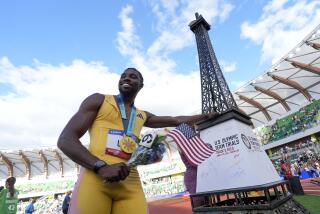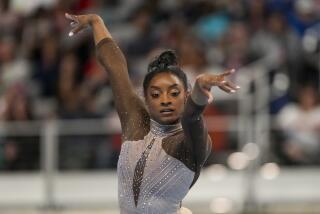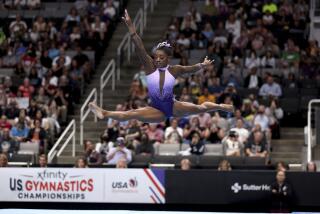Artistry puts Abbott on top
- Share via
CLEVELAND — Evan Lysacek skated better than he has all season, putting down a performance worthy of his stature as winner of the last two U.S. titles.
It wasn’t good enough, because Jeremy Abbott immediately followed with two minutes 40 seconds of skating that underscored his stature as the new star of U.S. men’s skating.
They were the first two skaters on the ice in Friday’s short program at the U.S. championships, and they made the 17 who followed seem irrelevant.
Abbott (86.40), of Aspen, Colo., and Lysacek (83.59), of Naperville, Ill., both topped the previous top score for a short program at nationals, 83.40 by Johnny Weir a year ago.
Weir became a non-factor after he popped the triple axel in his short program and wound up seventh with 70.76 points.
Parker Pennington, the 2001 junior champion whose senior career had been relentlessly underwhelming, took third
“I’m going to try not to cry,” Weir said. “The performance was a big disappointment.”
Before this season, this meet might have been presumed to be another round in the rivalry between Lysacek and Weir, who have won the last five titles.
“I feel like the national championships is always a little bit about Evan and Johnny,” Abbott said. “My goal was to maybe break through that.”
He did it with fluid, nearly flawless skating, belying the discomfort of having suddenly assumed a favorite’s role after becoming the top-rated U.S. man in the fall portion of the season. That included Abbott’s surprise win in the Grand Prix Final.
“Coming in as the Grand Prix champion, I put a lot of pressure on myself to almost be perfect, and I struggled a little bit with my training before I put all that aside,” said Abbott, 23, who was fourth at nationals the last two years.
Skating to the Albinoni “Adagio,” Abbott captured the minor-key mood of the haunting Baroque piece with his understated movements: effortless jumps, dynamic spins and expressive footwork sequences.
“I have seen Jeremy skate like this in training for a couple years now,” said his coach, Tom Zakrajsek.
After years of erratic performances that undermined his talent, Abbott has found a consistency that makes his recent skating draw comparisons to the late John Curry of Great Britain, the 1976 Olympic champion whom many regard as the consummate artist on ice.
“The artistic side of the sport is what drew me to it,” Abbott said.
Weir, who also thinks of himself as an artist, said a series of illnesses in November and December had sapped his strength as well as his confidence.
“I lost a lot of weight, and when you aren’t feeling strong as a person, it is hard to feel strong on the ice,” Weir said.
Lysacek and Abbott scored well on triple-triple jump combinations, but Abbott’s solo triple axel was so much better than Lysacek’s, accounting for much of his lead.
“Evan is a great champion, and Jeremy outskated him right after he skated well,” Zakrajsek said.
Lysacek’s more intense style also fit his music, Ravel’s “Bolero,” with its pulsating drumbeats and increasingly frenetic tempo.
But his costume, with crosses on front and back, was discordant, and his explanation muddled.
He said the reference was to the use of “Bolero” in a Spanish movie but added he had never seen the movie and did not know what it was called. It told what he called an “inappropriate” story, of a nun who goes to a monastery, with the music meant to express building sexual energy.
Earlier this season, though, Lysacek had said Tatiana Tarasova, who choreographed the program, had created the costume design simply because she likes crosses.
Only in figure skating.
--
More to Read
Go beyond the scoreboard
Get the latest on L.A.'s teams in the daily Sports Report newsletter.
You may occasionally receive promotional content from the Los Angeles Times.






